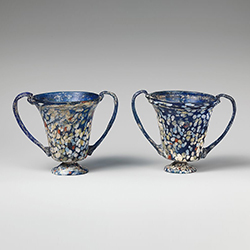Local Storage seems to be disabled in your browser.
For the best experience on our site, be sure to turn on Local Storage in your browser.
Chalice of Fluidity 2

Our Inspiration: A pair of glass drinking cups
Roman, Early Imperial, 1st century CE
Glass; blown and decorated with marvered blobs
Gift of Renée E. and Robert A. Belfer, 2012 2012.479.5a, b
Translucent cobalt blue, with same color handles; blobs in opaque white, red, pale blue, and yellow. Vertical rounded rim with collar below; body with concave sides, tapering downwards, then turned in at an angle to convex, slightly pointed bottom; low pedestal base applied from separate paraison, with splayed foot and knocked-off, unworked edge; two ribbed handles with central groove applied at bottom of sides, drawn up in a wide loop, curved in above rim, and pressed on to outer edge of rim.
Irregular pattern of marvered blobs on body and applied base.
Intact; iridescent weathering, dulling, and pitting, with some whitish encrustation, mainly on base and undercurve of body.
The elegant shape of these drinking cups is enhanced by their vibrant blue color and the use of applied blobs of glass in contrasting colors. This type of decoration, in which chips of differently colored glass were applied to the vessel and then marvered into the surface, was used for a relatively short time during the mid-first century A.D. Their production may be attributed to workshops in northern Italy.

Our Inspiration: A pair of glass drinking cups
Roman, Early Imperial, 1st century CE
Glass; blown and decorated with marvered blobs
Gift of Renée E. and Robert A. Belfer, 2012 2012.479.5a, b
Translucent cobalt blue, with same color handles; blobs in opaque white, red, pale blue, and yellow. Vertical rounded rim with collar below; body with concave sides, tapering downwards, then turned in at an angle to convex, slightly pointed bottom; low pedestal base applied from separate paraison, with splayed foot and knocked-off, unworked edge; two ribbed handles with central groove applied at bottom of sides, drawn up in a wide loop, curved in above rim, and pressed on to outer edge of rim.
Irregular pattern of marvered blobs on body and applied base.
Intact; iridescent weathering, dulling, and pitting, with some whitish encrustation, mainly on base and undercurve of body.
The elegant shape of these drinking cups is enhanced by their vibrant blue color and the use of applied blobs of glass in contrasting colors. This type of decoration, in which chips of differently colored glass were applied to the vessel and then marvered into the surface, was used for a relatively short time during the mid-first century A.D. Their production may be attributed to workshops in northern Italy.



